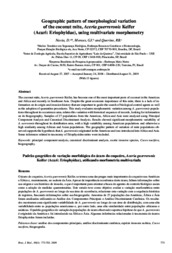Geographic pattern of morphological variation of the coconut mite, Aceria guerreronis Keifer (Acari: Eriophyidae), using multivariate morphometry.
Geographic pattern of morphological variation of the coconut mite, Aceria guerreronis Keifer (Acari: Eriophyidae), using multivariate morphometry.
Author(s): NAVIA, D.; MORAES, G. J.; QUERINO, R. B.
Summary: The coconut mite, Aceria guerreronis Keifer, has become one of the most important pests of coconut in the Americas and Africa and recently in Southeast Asia. Despite the great economic importance of this mite, there is a lack of information on its origin and invasion history that are important to guide the search of biological control agents as well as the adoption of quarantine procedures. This study evaluates morphometric variation among A. guerreronis populations throughout its occurrence area, relates this variation with historical sequence of records, looking for information on its biogeography. Samples of 27 populations from the Americas, Africa and Asia were analysed using Principal Component Analysis and Canonical Discriminant Analysis. Results showed significant morphometric variability of A. uerreronis throughout its distribution area, with a high variability among American populations and otherwise a high similarity among African and Asian populations. The geographic pattern of variation of mite populations observed supports the hypothesis that A. guerreronis originated in the Americas and was introduced into Africa and Asia. Some inferences related to taxonomy of Eriophyoidea mites were included.
Publication year: 2009
Types of publication: Journal article
Unit: Embrapa Mid-North
Observation
Some of Embrapa's publications are published as ePub files. To read them, use or download one of the following free software options to your computer or mobile device. Android: Google Play Books; IOS: iBooks; Windows and Linux: Calibre.
Access other publications
Access the Agricultural Research Database (BDPA) to consult Embrapa's full library collection and records.
Visit Embrapa Bookstore to purchase books and other publications sold by Embrapa.

